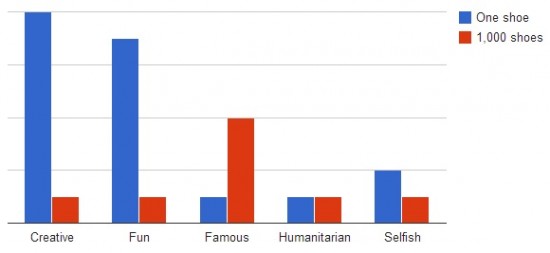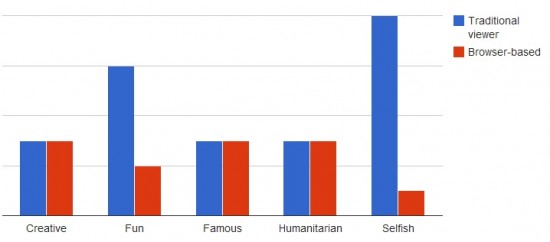In virtual worlds, the question of free stuff — free content, free software, free land — comes up a lot.
Some people love free stuff. Some people hate it.
Some people say that all content should be free because there are no distribution costs. Some people say that content should cost money because the creators spent real time making it.
I’m not saying that all stuff should be free all the time. I’m saying that there are reasons why some stuff is sometimes free.
But from a practicality standpoint, there are five main reasons why stuff is free.
1. People like to express themselves
The more artistic and creative a particular activity is, the more people there are doing it for free. Writing poetry and plays and short stories. Cooking. Taking funny pictures of cats. Singing, Acting. Painting sunsets. Designing a garden. Decorating a house.
Some people love expressing themselves so much that they’ll take classes to learn how to cook, write, paint, or sing. They’ll spend money on art and gardening supplies, at karaoke bars, on buying new furniture.
That’s not to say that it’s impossible to make money by being creative. Lots of people do. There are successful musicians, artists, and authors all over the place. Well, maybe not all over the place. But in some places.
The ones who are successful tend to have some combination of luck, connections, talent, dedication, and hard work. In fact, you will often find that the most successful people in these fields are not necessarily the most creative.
2. People like to have fun
People like to play sports and video games. Gossip about their friends. Dress up in fancy clothes. Shop. Eat. Watch movies. It is very easy to get people to do fun stuff for free. In fact, they’ll often pay you money for the opportunity to do something fun.
It is extremely difficult to make money by having fun. It helps if your idea of having fun is very different from those of other people. For example, if you think accounting is fun, you’re a very fortunate person.
3. People crave recognition
It’s nice to be famous. To be appreciated. Sure, the kind of fame you get in the virtual worlds isn’t quite at the same level as being on a television reality show, or starring in a viral YouTube video, but for some people, a little bit of recognition and appreciation is just fine.
That is certainly one reason why I have Hypergrid Business, for example. I may not have as many readers as I do on my day job (check out my latest articles on PC World or Network World, for example), and I don’t get to be on TV as much as I did back when I was running a news bureau in Shanghai. But then again, only Hypergrid Business readers call me up in the middle of the night to yell at me, threaten me with lawsuits, and send me nasty emails — but also send me nice emails, send donations and buy the ads that pay for freelancers so I’m not writing everything alone.
4. People want to be helpful
If there’s a tsunami, they’ll make a donation. They’ll volunteer to build houses for the homeless and feed the hungry and rescue people from burning buildings. The bigger the need, the more likely it is that people will step up and help out.
5. People want to help themselves
I occasionally create textures or scripts for my own use. I try to share as many as I can under a CC0 public domain license. I’m making the stuff for myself, anyway, so it doesn’t cost me anything extra to share it.
Plus, if I do share it, other people might improve on it — fix bugs, add functionality — which is all to the good. To my good. I don’t even mind if people take the stuff, package it up, and sell it. Packaging and selling is hard work. I don’t want to do that hard work. If someone else does, it’s no skin off my nose.
Many open source projects start out just like this. A company builds a product for its own use but if it doesn’t offer any particular competitive advantage, why not share it? Then, once you have shared it, you’ve got a lot more people working to support it or to improve on it.
Some examples of these principles in practice
If you want to see millions of examples of free creative content, just go online. I’m not talking about the illegal filesharing sites, even. Cat photos, bad musical performances, home-made videos fan fiction. There’s a wealth of home-made creative content out there. If you search Flickr for “photo” you get 72 million results. Limiting the results to just those licensed as Creative Commons still leaves you with 9 million free-to-look at and free-to-use photos.
If you’re getting your music for free (legally) it probably falls into one of the categories above. It’s the artist’s personal creative expression, not a packaged studio product. It was fun to make. The artist wanted to get some extra exposure. The artist donated the music for a good cause, such as famine relief. Or you’re getting the music for free so that you’d be inspired to buy the artist’s new album, see their next concert, or buy whatever product their music is helping to advertise. And there are also some artists who believe that music, like food, is a vital human need and want to make sure that nobody is deprived of it through inability to pay.
Virtual shoes
- Does the artist get to express themselves? Maybe. Some people do find a creative outlet in designing shoes.
- Are they fun to make? Again, maybe. But a lot of it is repetitive, hard work. Making the same pair of shoes in different sizes, colors, and with slight style differences can turn in work really quickly.
- Does the artist get recognition? Maybe, maybe not. I certainly don’t remember the names of the folks who made my virtual shoes, though some of them have the creator’s name right in the title, or the folder name, so then it’s easier to learn their names.
- Do people need virtual shoes? Really, no. In fact, nobody really needs most of the virtual stuff we consume — not virtual clothing or accessories, not music or movies or books, not video games. We can all live without most of that stuff. It’s not food or shelter. Back when I was a kid, all we had to entertain us was a stick and a clod of dirt and Gilligan’s Island and we managed just fine.
- Does it benefit the creator to distribute the shoes for free? Maybe — the shoes could be last year’s fashion, and by offering them as freebies, they can drive traffic to their store. Or they’re making the shoes for their own use anyway, and by offering them others, other people might build on that base, creating more varieties.

Now, on to two other types of content that could be free or open source but aren’t. Or, at least, not fully.
Browser-based viewer
- Writing viewer code is not a particularly creative experience. You’re not really inventing something brand new, after all, but implementing functionality that already existing in other viewers, in both browser-based and standalone software varities.
- It’s mostly hard work. Especially when you add in debugging, documentation, end user support… there’s a lot of hard, tedious, and unpleasant work involved here.
- Unless the developer put their name right in the title of the viewer, they’re not going to get much public recognition for their work.
- A browser-based viewer is not a necessity.
- Developers don’t personally need a browser-based viewer. They good at technology, and have no problems installing the standard viewer software and learning how to use it. Enterprise users who need a browser-based viewer are more likely to turn to an existing commercial alternative rather than building one themselves from scratch.

So it doesn’t surprise me that PixieViewer’s OpenSim module will only be free for non-commercial use. PixieViewer itself will be open source, but it requires some add-on code to allow it to work with OpenSim.
The only other serious attempt to create a general-purpose, browser-based viewer for OpenSim was Tipodean’s Unity-based viewer, which that company also planned to have a commercial component.
Finally, there’s SpotON3D’s browser plugin, but that only works in conjunction with the grid’s own services.
I’m glad that PixieViewer itself is open source and don’t begrudge the developer any plans he has for commercializing the OpenSim module itself. Otherwise, we might not have any browser-based viewer at all for the foreseable future.
Easy OpenSim configuration tool
Writing a software installer and configuration utility is not a particularly creative task, nor is it fun, nor is it likely to make the developer famous. Plus, developers have no trouble installing the software from scratch, so they don’t need an easy installer. Plus, you’ve got all the hassles of dealing with routers, of providing support, and of designing a user interface.
So, again, I’m not surprised that the developer of New World Studio is looking to make a commercial version of the product. All the basic components will be free, such as the OpenSim itself, the Diva Distro-based parts, and so on. The only commercial part will be a separate add on that has extra configuration options.
I’ve used New World Studio before, and am a big fan, and plan to download the new version the minute its released.
I also plan to upgrade to the premium features of the commercial version, when that comes out.
I’ve run OpenSim from scratch using the software downloads at opensimulator.org, have installed and run the Diva Distro, have used Sim-on-a-Stick, and found a significant improvement in usability with each new step. New World Studio takes that usability and ease of installation even further, to where you just click on a couple of buttons, come up with a name for your avatar, and you have your own grid.
Again, I don’t begrudge the developer any money he makes from the sale of the premium version.
Open source clones
Finally, one more note about commercial software.
Folks who make the commercial software are often breaking new ground, investing the time, and, often, investing their money as well.
If a product becomes successful, they can make a lot of money — but then the likelihood that some of its individual or corporate users will reverse-engineer it and create an open source version goes way up. Individual developers will work on it because they want a free version of that product for their own use. And companies will sponsor open source efforts to reduce their own software costs.
So we have an open source version of Microsoft Office in OpenOffice. Instead of Photoshop, many people use GIMP. OpenSim itself is an open source alternative to Second Life.
Even Netscape was originally a commercial product.
So I don’t mind paying money for an OpenSim viewer, or an OpenSim installer, if it helps move the technology forward. And, eventually, it will probably all be free and open source anyway.
- Classic metaverse books on sale now at Amazon - May 16, 2024
- All OpenSim stats drop on grid outages - May 15, 2024
- 3rd Rock Grid residents find new homes on ZetaWorlds - May 14, 2024
